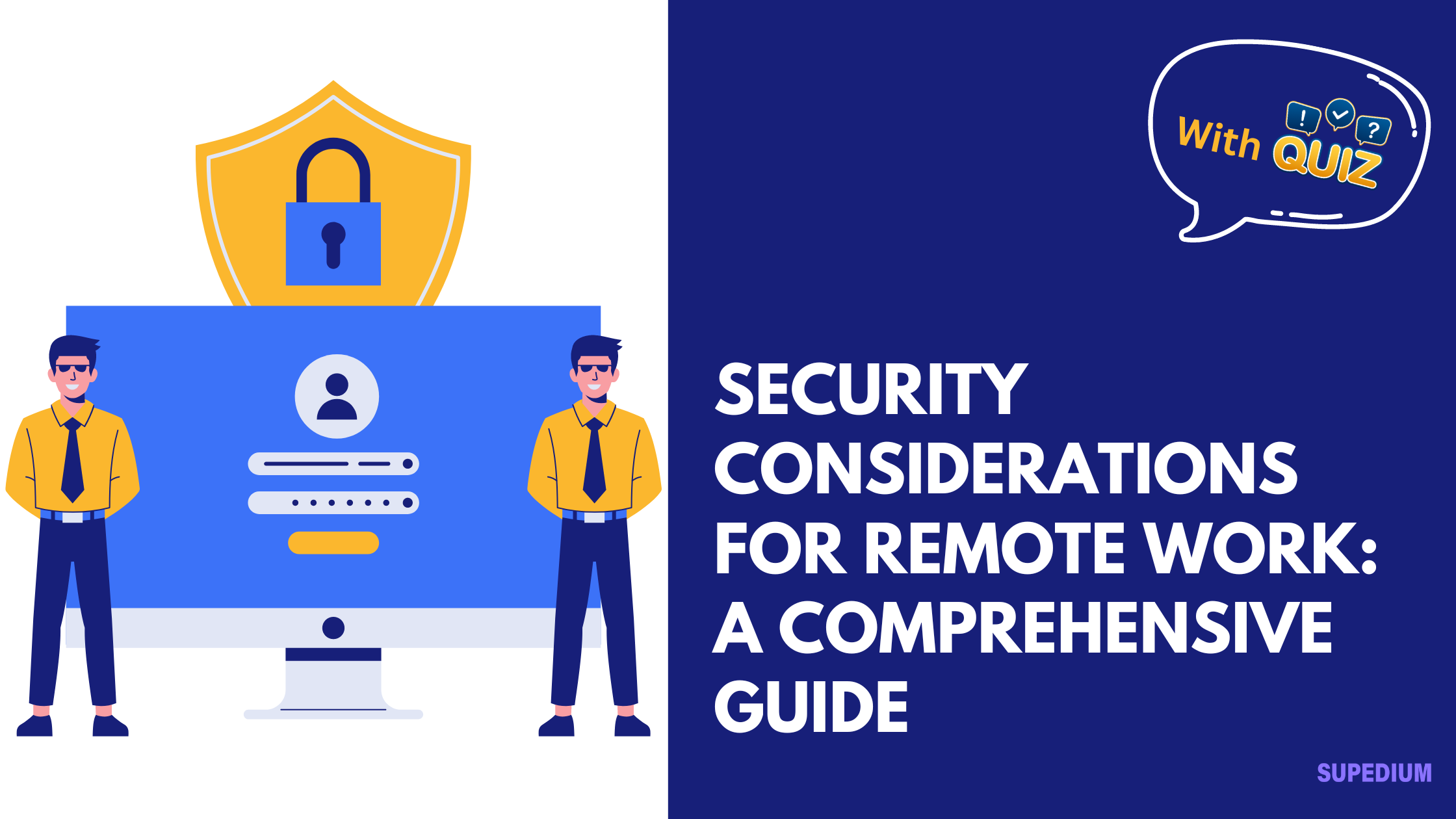Table of Contents
- 0.1 I. Introduction
- 0.2 II. Security Challenges in Remote Work
- 0.3 III. Best Practices for Remote Work Security
- 0.4 IV. Organizational Policies and Training
- 0.5 V. Tools and Technologies for Enhancing Remote Work Security
- 0.6 VI. Compliance and Legal Considerations
- 0.7 VII. Future Trends and Emerging Threats
- 0.8 VIII. Conclusion
- 1 Quiz Time
![]()
The rise of remote work has transformed the modern workplace, allowing employees to work from virtually anywhere. This shift has been driven by advances in technology and changing attitudes towards work-life balance. However, as organizations embrace remote work, they face new security challenges that require careful consideration and proactive measures. This article explores the key security considerations for remote work, offering insights and best practices to help safeguard sensitive information and maintain robust security.
I. Introduction
A. Definition and Growth of Remote Work
Remote work, also known as telecommuting, refers to the practice of working outside a traditional office environment. This can include working from home, co-working spaces, or other remote locations. The adoption of remote work has accelerated in recent years, driven by technological advancements, evolving workforce expectations, and global events such as the COVID-19 pandemic. According to recent statistics, a significant portion of the workforce now engages in remote work, with many organizations offering flexible work arrangements as a permanent option.
B. Importance of Security in Remote Work
As remote work becomes more prevalent, the security of digital assets and sensitive information becomes increasingly critical. With employees accessing company resources from various locations and devices, the risk of data breaches and cyberattacks rises. Ensuring robust security measures is essential to protect against unauthorized access, data loss, and other potential threats.
II. Security Challenges in Remote Work
A. Data Protection
One of the primary concerns in remote work is the protection of sensitive data. Data breaches can occur due to various factors, including inadequate security measures, human error, or targeted cyberattacks. To mitigate these risks, organizations must prioritize data encryption both in transit and at rest. Encryption ensures that even if data is intercepted or accessed without authorization, it remains unreadable without the appropriate decryption keys.
B. Network Security
Remote employees often use home networks, which may not be as secure as corporate networks. Unsecured home networks can expose organizations to various risks, including unauthorized access and data interception. Implementing Virtual Private Networks (VPNs) is a crucial step in securing remote connections. VPNs create an encrypted tunnel for data transmission, helping to protect sensitive information from prying eyes.
C. Device Security
The use of personal devices for work purposes introduces additional security risks. Personal devices may lack adequate security protections and can be more vulnerable to malware and other threats. Organizations should implement strategies to secure these devices, including enforcing strong passwords, enabling biometric authentication, and ensuring that devices are regularly updated with the latest security patches.
D. Phishing and Social Engineering
Phishing attacks and social engineering tactics are common methods used by cybercriminals to gain unauthorized access to sensitive information. Phishing typically involves fraudulent emails or messages that appear to be from legitimate sources, tricking recipients into revealing personal information or clicking on malicious links. To combat these threats, employees should be trained to recognize and report phishing attempts and other social engineering tactics.
III. Best Practices for Remote Work Security
A. Secure Access Controls
Implementing secure access controls is essential for protecting organizational data. Employees should use strong, unique passwords for their accounts, and password management tools can help ensure that passwords are not reused across multiple sites. Multi-Factor Authentication (MFA) adds an extra layer of security by requiring users to provide additional verification, such as a code sent to their mobile device, in addition to their password.
B. Regular Software Updates
Keeping software and applications up-to-date is crucial for maintaining security. Software updates often include patches for vulnerabilities that could be exploited by attackers. Organizations should implement a robust patch management process to ensure that all systems and applications are updated promptly and regularly.
C. Data Encryption
Encrypting sensitive data is a fundamental practice for protecting information from unauthorized access. Encryption should be applied to data both during transmission and while stored. Secure file-sharing practices, such as using encrypted communication tools and services, help ensure that data remains protected when shared with others.
D. Network Security Measures
Configuring firewalls is an important step in protecting remote networks from external threats. Firewalls act as barriers between internal networks and external networks, filtering out malicious traffic and preventing unauthorized access. Additionally, employees should use secure Wi-Fi networks, and public Wi-Fi should be avoided for accessing sensitive information.
E. Secure Communication Channels
Using encrypted communication tools is vital for ensuring the confidentiality of remote communications. Organizations should adopt secure messaging and video conferencing platforms that offer end-to-end encryption to protect against eavesdropping and unauthorized access.
IV. Organizational Policies and Training
A. Developing Remote Work Policies
Establishing clear remote work policies helps set expectations and guidelines for employees. Policies should cover acceptable use of technology, procedures for reporting security incidents, and guidelines for maintaining data security. Well-defined policies ensure that employees understand their responsibilities and the measures they need to take to protect company resources.
B. Employee Training and Awareness
Regular cybersecurity training is essential for keeping employees informed about potential threats and best practices for maintaining security. Training programs should cover topics such as recognizing phishing attempts, securely handling data, and understanding the importance of strong passwords. Phishing simulation exercises can also help employees practice identifying and responding to phishing attacks.
C. Incident Response Plans
An effective incident response plan outlines the steps to take in the event of a security breach or other incident. The plan should define roles and responsibilities, communication protocols, and procedures for containing and mitigating the impact of the incident. Regularly testing and updating the incident response plan ensures that the organization is prepared to handle security incidents effectively.
V. Tools and Technologies for Enhancing Remote Work Security
A. Endpoint Protection Solutions
Endpoint protection solutions, such as antivirus and anti-malware software, are critical for safeguarding devices from malicious threats. Endpoint detection and response (EDR) solutions provide advanced capabilities for monitoring and responding to security incidents on endpoints. These tools help identify and address potential threats before they can cause significant harm.
B. Virtual Private Networks (VPNs)
VPNs play a crucial role in securing remote connections by creating an encrypted tunnel for data transmission. Using a reputable VPN provider ensures that employees’ online activities are protected from eavesdropping and unauthorized access. Organizations should provide employees with guidance on selecting and using VPNs to maintain secure connections.
C. Secure Collaboration Tools
Collaboration tools are essential for remote work, but it’s important to choose tools that offer robust security features. Secure collaboration platforms provide encryption for communications and file sharing, access controls to manage permissions, and audit logs to track activity. Organizations should evaluate collaboration tools based on their security features and ensure they meet organizational security requirements.
VI. Compliance and Legal Considerations
A. Data Privacy Regulations
Compliance with data privacy regulations is a key aspect of remote work security. Regulations such as the General Data Protection Regulation (GDPR) and the California Consumer Privacy Act (CCPA) impose requirements on how organizations handle and protect personal data. Organizations must ensure that their remote work practices align with these regulations to avoid legal penalties and maintain customer trust.
B. Industry-Specific Regulations
Certain industries, such as healthcare and finance, have specific security standards and regulations that must be adhered to. For example, the Health Insurance Portability and Accountability Act (HIPAA) sets standards for protecting health information, while the Payment Card Industry Data Security Standard (PCI DSS) outlines requirements for handling payment card data. Organizations in regulated industries should implement security measures that meet industry-specific requirements.
VII. Future Trends and Emerging Threats
A. Evolution of Remote Work Security Threats
As remote work continues to evolve, new security threats and challenges are likely to emerge. For example, advancements in artificial intelligence (AI) and machine learning may lead to more sophisticated cyberattacks. Staying informed about emerging threats and adapting security measures accordingly is essential for maintaining a strong security posture.
B. Proactive Security Measures
To stay ahead of new threats, organizations should invest in advanced security solutions and adopt a proactive approach to security. This includes continuously monitoring for potential threats, implementing threat intelligence tools, and staying current with the latest security trends and technologies.
VIII. Conclusion
As remote work becomes a permanent fixture in the modern workplace, addressing security considerations is more important than ever. By implementing best practices, developing robust policies, and leveraging advanced tools and technologies, organizations can protect sensitive information and maintain a secure remote work environment. Continuous improvement and vigilance are key to staying ahead of evolving security threats and ensuring the safety of organizational data.






Be the first to comment